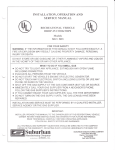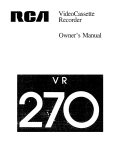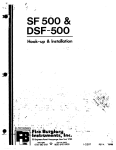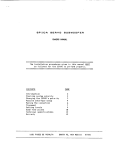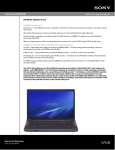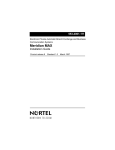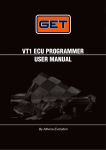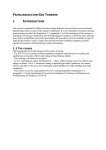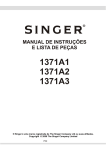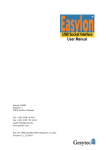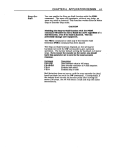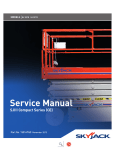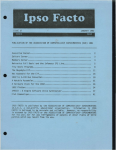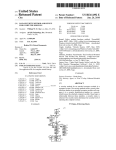Download Linked - Softouch Information Services
Transcript
GENERATING AND
TESTING
PSEUDORANDOM
NUMBERS
BY CHARLES
A.
WHITNEY
c!J
-
IJ ~/_
;:~ 11:r.~
~_,..r
7,:r
Ill
BYTE • OCTOBER 1984
j)
.r
ILWSTRATED BY MACIEK ALBRECHT
Analyze haphazard occurrences with linear congruential generators
FA DRUNKARD starts from a
Before going further. I should try to
lamppost and randomly stag· clarify a point of language that can
gers away. how far will he have lead to confusion. Strictly speaking.
progressed in one thousand no such thing as a random number
steps? Expressed in varying forms. the exists-only a random process. The
"drunkard's walk" has become a number 12345 is neither less nor
staple of mathematical physics. How more random than the number
far will an impurity atom migrate in a 32719. In a series of 100.000 random·
crystal lattice? How many steps will be ly generated numbers. both of these
required for a photon to emerge from
would have the same chance of oca foggy atmosphere? They are all the curring. The idea that 12 34 5 is less
same question. and they can be random comes from comparing it
treated with "Monte Carlo" calcula- with a simple pattern of ascending
tions. These calculations are finding digits. Thus. instead of saying you are
increasing applications in business. as trying to produce random numbers.
well. For example. they provide an you should say you are trying to con·
analysis of how best to serve struct a method that will produce a
customers arriving haphazardly at a series of numbers that imitates the
counter. Carrying out such calcula· results of a random process. But for
tions depends on being able to imi· the purpose of this article. I will use
tate randomly generated numbers. the word "random" more loosely to
and this is not easy. It has been said refer to a random sequence or a ran·
that more time has been spent gen- ·dom number. without worrying about
erating and testing random numbers the niceties. If a sequence looks like
it was generated by a random prothan using them.
You can find numerical examples of cess. I will call it random and will put
random series all around you. The off the question of how to judge apfinal integers in a list of telephone pearances until I discuss methods of
numbers gives a good random series testing random-number generators.
1b carry out a Monte carlo calculain the range 0 to 9. The face values
of cards drawn from a well-shuffled tion. you need to work with random
deck and the final digits in license- numbers inside a computer. But you
plate numbers on passing cars are are faced with the fact that a purely
usually quite reliable. (But the first digital computer is a deterministic
digits of such numbers are often far machine-except on its "off" daysfrom random.)
and such a device cannot truly
The property that defines a ran- generate a random process. You have
domly generated series is that each to be satisfied with deterministic
number is independent of all earlier algorithms that imitate random pronumbers. In other words. the process cesses. You can thus generate
that generates the random series has "pseudorandom" numbers with some
no memory. Therefore. even if you of the earmarks of randomness.
know all the previous numbers. you Naturally. some random-number
cannot predict with certainty the next generators work better than others.
one. (And if you have been losing at and you must be wary.
a truly random game. you have no
reason to think you will start winning.) LINEAR CONCRUENTIAL
That's why flipping a coin is such a GENERATORS
good method of generating a random Mathematicians have suggested many
series of zeros and ones. Each flip is methods for generating pseudoranentirely independent of the others.
dom numbers with a digital computer.
Happily. the most common and
powerful one involves simple arith·
metic. This method is the linear congruential generator. or L.CG for short.
An LCG produces a series of
numbers. /,. where the subscript "i"
indicates the location of the number;
i - I indicates the first number. i 3 is the third. and so on. Since each
successive term. 1,. 1• is computed
from its predecessor. you can see
right awa'j that this series is not truly
random because it has memory. That
is why the L.CG is called a "pseudorandom"·number generator.
1b understand the L.CG. look at the
following linear expression:
1;. 1
-
al, + c. (a > 0. c :i!:: 0)
This expression multiplies each
number by the factor a and then adds
cto find the next member. It produces
an ascending series of numbers
whose differences are given by the
expression
/ 1• 1 -
11 - (a-1)11 + c
We call the process "mapping"
because it carries the integer. I, to
1,. 1• from one point to the next in a
one-dimensional space. as shown in
figure I.
Suppose a - 2 and c - I; then you
have I. 3. 7. 15. As i~ stands. this series
doesn't look random. 1b create a
series that looks random. you need a
method of scrambling the output.
perhaps by cutting off the upward run.
One way to achieve this appearance
is to imagine you've subdivided the
number line representing the /-space
into segments of length '"· If you
make the multiplier. a. in the L.CG suf-
w"'''"lltll o11 , . 4421
Clulrlts A. WilitJit!l is a ph!lsicist at tilt
HarwmJ-Smitilsofliall Cntttr for Astropfr!l5ics
(60 Cardell St .. Cambridgt. MA 021 38)
arul is a professor of astronom11 at Harvard.
I
OCTOBER 1984 • BYTE
129
RANDOM NUMBERS
(amti"ued from page 12 9)
ficiently large (compared with the segment length. m). the mapping will take
the point out of the current segment
at each jump. The successive positions of the point within each segment will then be an erratic function.
You can consider these successive
positions pseudorandom numbers if
you suppose each segment is renumbered from 0 to m-1. as in figure 2.
You can accomplish such a subdivision of the /-space by introducing the
modulus function
mod(/.m) - I - !IImlm
11•
where llfml is the integer part of the
quotient. derived by truncation.
;::::::::::::::::::::::::::::::::::::::::::::::::;;;;;;;;:::::::::;;;::;;;:;;;:;;;ll
IBM. Person•l Computer
MONITORS
Amdek 300
Amdek 300A
Amdek 310A
Amdek Color I
Amdek Color II
PG5-HX-12
PGS-MAX-12
PGS-SR-12
IBM Monochrome Display
IBM Color Display
256KB Memory, DS/DD Drive,
FDC, Color Card, Amdek 300
$139.00 Monitor with 10MB Hard Disk
$159.00 Sub System .
$179.00
Best Price
Best Price
480.00
195.00
s
s
Best Price
$265.00
$590.00
PRINTERS
Epson FX 80
$499.00
Epson FX 100
$699.00
Okidata 92 A
$465.00
Okidata 93 A
$699.00
Okidata ML 84
$899.00
Okidata 2410
$2085.00
Okidata 2350
$1925.00
Toshiba P1351 & 1340
Best Price
NEC Spinwriters 3550
$1699.00
NEC Spinwriters 7730
$1799.00
C-ltoh Starwriter 40CPS
Best Price
C-Jtoh Printmaster 55CPS
Best Price
Gemini 10X
$290.00
Gemini 15X
$399.00
Also available DX-15, HR-25, HR-35, &
Silver-Reed.
DRIVES
Tandon TM 1()()-2
$205.00
Slimline Drives- Your Choice- Toshiba.
Hitachi, Panasonic
$175.00
$2899.
(We configure and test the system
~fo=r=y:::o:::u::::a::t::n::o::::e::x::_:tr::a~c::o::st~)~::::=::=::::"
MULTIFUNCTION BOARDS
$179.00
AST 1/0 + Ser & Par
$269.00
AST Six Pack 64K
$269.00
AST Mega Plus 64K
$269.00
AST Combo 64K
$269.00
Quadboard 64K
$225.00
IBM Color Graphic Adapter
$240.00
IBM Mono/Printer Adapter
$359.00
Hercules Graphic
Best Price
Plantronics
Paradise Multifunction Card Best Price
Best Price
Orchid - Blossom
$50.00
64K Ram Upgrade Kit
MODEMS
Hayes Smart Modem 1200
Hayes Smart Modem 300
Hayes 1200B Plug in Modem
Card
When. for example. mod(ll.3) - 2. the
result always lies between 0 and m-1.
In some forms of BASIC. this is written II MOD 3.
Now rewrite the mapping as
$489.00
$209.00
$429.00
HARD DISK FOR IBM PC
10MB Hard Disk Sub System includes:
Software, Controller Cables, Etc.
Internal
$875.00
External
$1025.00
Many other products available, Please call for low -low Prices!
~
2640 Walnut Ave., Unit K, Tustin, CA 92680
(714) 838-7530
Prices & availaility subject to change without notice -IBM is a registered trademark of IBM Corp.
1 -
mod (a/, + c.m)
This equation is a general form for the
LCG. and it produces a series of integers in the range 0 < /1 < m- I .
Three parameters describe this mapping: the multiplier (a). the difference
(c). and the modulus (m).
Often it is convenient to "normalize"
the values. dividing each by the
modulus. The result is a series in the
range 0 to (m- I )/m < I . which can be
written as
X;. 1 -
Fl..OAT(/1• 1) /FLOAT(m)
Note that the smallest nonzero difference between terms is 1/m. which
means the numbers the LCG produces comprise a set of m equally
spaced rational fractions in the range
0 :S x :S (m-1)/m.
1b see some of the properties of
series that are generated this way.
look at the following series:
1,.1 - mod (51 1 + 3. 8)
By starting with an arbitrary value. the
I. you find
I. 0, 3. 2. 5. 4. 7. 6. I. 0. 3. 2. 5.....
This series starts off with a haphazard appearance. but since it
repeats itself every 8 terms. it is said
to have a "period" of 8. It is not hard
to see why this is the period. First. the
modulus of the series is 8. so the
series cannot have more than 8 integers. (You remove larger integers by
subtracting the modulus.) Second. the
series is deterministic. Each appearance of a particular integer must
be followed by a uniquely determined
integer. That is. each appearance of
"2" must be followed by ''5:' As a
result. the series must repeat itself
with a period no longer than its
modulus.
This reasoning suggests adopting a
large modulus if you want a long
period. But it isn't the only possibility. Some generators will skip many of
the possible numbers and give an in-
"seed:· and taking / 1
(cortti"ued)
442
B Y T E • OCTOBER 1984
Orde 232 on Inquiry card.
RANDOM NUMBERS
5 and m - 8 for various values of the
additive constant. c. 'lake the first
series as an example. If you use a
seed. 6. you obtain the pseudorandom series 6. 7. 4. 5. 2..... If you
use the seed 5. you get 5. 2. 3. 0. I.
generate subsets of integers with
many useful properties. In the first
place. the sum of the periods of the
subsets equals the modulus of the
series. This property helps you decide
whether you have found all the
6.....
subsets. Second. if the series does not
Because several of the series in have a full period. different seeds start
table I do not have a full period. they each subset. For example. the series
with c - 4 has six subseries of periods
- - - - - - - - - - - - - - - - - - - - - - - - - - - - , I or 2. and the seed you use will
determine which subseries you
generate.
When you set up a random-number
generator. look for a long and full
period because it will produce the
richest set of numbers. Several established rules for selecting the parameters will achieve a full period. These
rules are discussed in Donald Knuth's
complete set of "random" numbers.
A series that generates all of the m
distinct integers (0 < n < m-1) during each period is called a "full
period:· Whether a series will have a
full period or not depends in large
measure on the values you choose for
the parameters (a.c.m). Thble I illustrates some of the series with a -
Graphics
with
Gray
Matter.
The Art of Computer Programming.
New GRAPHICs-PLUS GP-29. Big Features. Uttle Cost.
The GP-29 delivers the graphics
and text versatility of powerful,
expensive terminals at significant
cost savings. And you can buy
the GP-29 as a ready to use terminal or as a retrofit board for the
Zenith Z29.
Expand your applications with
dual plane graphics. Create images
with "shades of gray." Overlay
two separate images. Animate the
images. Store multiple images in
local memory.
The GP-29 gives you low cost
graphics you never imagined possible. 1024 x 500 hi-res and 512 x 250
lo-res selectable resolution . 128k of
display memory. And our dedicated graphics processor provides
selective vector erase, area erase,
area fill, area move, arc drawing,
pan and zoom.
You also get Tektronix 4014 compatibility as well as DEC VTlOO and
VT220 compatibility.
Enhanced Text Tool
The GP-29 offers four selectable
display formats: 80 and 132 columns with 24 or 49 lines. Offscreen scrolling memory. Storage
for pages and pages of text. Offline editing capability. Double high
and double wide characters and
much, much more.
Plus, you get operator convenience features like "plain English"
set-up menu, easy to use programmable keys, local function keys,
transparent mode and non-volatile
memory. And a serial printer port
is standard. Call or write today to
place your order.
GP-29 retrofit for Zenith Z29 • .• • S 995.
GP-29 complete terminal. • • . . . . . 1695.
OpttonM long-pe;slstence CRT . .
95.
Northwest
D igital Systems
P.O . Box 15288, Seattle, WA 98115
(206) 524-0014
GP-19 board for the Zenith Zl9 terminal is also available for S695.
444
BY T E • OCI'OBER 1984
Orde 252 on Inquiry c.-rd.
referenced at the end of this article.
One rule is that the modulus. m. and
the constant. c. must have no factors
in common. Another rule is that a
must be greater than the square root
of m (a > ...{;.)to avoid the serial correlation that upward runs produce.
(This rule ensures that the mapping
quickly takes the number out of the
current segment. the same condition
mentioned earlier.) Finally. you will get
the longest possible periods if the
modulus is a prime number equal to
or less than the largest integer your
computer can handle. (For a 16-bit
processor. this condition implies that
m :S 32 .768.)
'TWo additional examples of LCGs
with short. full periods follow:
1,+ 1
-
mod(71 1 + 5.9)
11+1
-
mod(71 1 + 7.9)
In practice. you develop a pseudorandom-number generator in a cutand-try process. testing and modifying various possibilities.
In describing the LCG. I assumed
that the coefficients were all integers.
You can increase the series' apparent
period by taking real (decimal) values.
For example. if you substitute 5.1 and
3.Ill for the coefficients in the series
above. the terms won't repeat precisely after a period of eight terms. But
the terms in successive cycles will
(COIIti"ued)
RANDOM NUMBERS
show only a slight shift. and the overall pattern of the cycle will be the
same-except for occasional jumps
when the fractional parts accumulate
sufficiently. Thus. the increase of
period is only illusory. and. since I
don't want to fool you with this illusion. I will restrict myself to integer
coefficients.
STATISTICAL 'JESTS
FOR RANDOMNESS
Often. you can look at a series and
see that it was probably not generated by a random process. For example. who would claim that a real coin
would lead to a series of heads (H)
and tails (T) such as HTHHTTHHHTTTHHHHTTTIHHHHHTITIT? It could
happen (with a probability of about
(1 /2) 29 - 0.000000001) . but you
wouldn't expect it in your lifetime.
But some series are not so obvious.
and you need a more reliable test
than the eyeball and a hunch. For this.
you must compare some statistical
properties of the series with some
theoretical predictions you make after
assuming that the series was generated by a truly random process. When
I refer to a statistical property, I'm talking about one that is independent of
the seed you used to start the series.
including those tests that are obliv-
446
BYTE • OCIOBER 1984
THE
CHI-SQUARE TEST
T
his test is commonly used for
agreement between a series of
observed values. 0 1• and expected
values. E,. In this case. the "observations" are the actual bin populations
listed in table 2. and the expected
value is the average 1000/100 - 10.
There are " - I 00 observations. and
because " > > I. the test can be expressed in a simplified form. as follows.
For each bin compute the difference.
0 , - E,: square these values. divide by
the corresponding value of E1• and
sum the quotients over all the observations. Divide the result by the
number of observations. obtaining
)(l -
(1/")I: 10, - E,PIE,
If this quantity lies between 0. 5 and
2.0. the scatter of the observations is
consistent with random numbers. If
X 2 < 0 .5. the observations are
suspiciously close to average values:
if )(l > 2.0. they are too far from the
average. This test is applicable only to
quantities that are expected to obey
the classic law of errors-and this is
often a debatable point. For the
numbers in table 2. X 2 - 0.79; therefore. the populations have the properties of random numbers.
ious to the order of terms in the
series. (The mean value is one such
property.) These statistical tests reveal
how likely it is that a random process
generated a certain series.
No statistical test is a sure bet. and
few tests are reliable in themselves.
Some pseudorandom series will pass
one test with flying colors. only to fail
miserably in another. Therefore. you
have to apply several different tests.
I will apply some tests to the LCG and
the generator that the IBM PC's Advanced BASIC supplies. Then I'll discuss how to develop a more powerful random-number generator that
anyone can use.
Let's start with the simplest test:
determining the period of the series.
PERIOD
You can determine a period by noting
a series· first number and then stepping through it while computing one
number after another until the first
number recurs. that is. until x. - x1•
Then n- I is the period of the series.
(In order to ensure that x. is. indeed.
the start of a repeat cycle. the first few
values. x1 - x1.,. can be saved for
comparison with x. - x•• ,.)
Figure 3 shows the unfortunate effect of a short period on the random
(co"ti"utd)
Orde 0 on Inquiry e~~rd.
3M
RANDOM NUMBERS
diskettes
5% "
Spec1fy soft,
10 or 16 seclor
Pnce 10.90
PriCe 100 +
1.90. 1.75.
2.45. 2.30.
Single Sided
double density
Double sided
double density
Certlfl!d Checlt • Money Order • Plrsonal Clleck Allow Ull
to 2 wee1<s lor pe~ checks kl clear Add S3 00 per 100
or part kl each order for UPS slliPP"'I chirges
NJ Residl!flts add ~ Siles laX
0
special distribution laws (the normal
distribution. for example). but I will
consider only the ones that are intended to produce uniformly distributed numbers. If I normalize an L..CG.
my program should produce numbers
in the range 0 to 1.0 with equal prob-
ability. However. the numbers won't
arrive in a perfectly uniform way. They
will exhibit a tendency to clump. just
as the flips of a real coin will show
runs of more than one head or tail instead of HTHTHT.
(COfttirrwtd)
4-z:-4
~+UNGE. INC
178 Route 206 South, P.O. Box 993
Somerville, N.J . 08876 • {201) 874-5050
12.5 f~
z
~
~
<
10.0 f7.5
~ 5.0
E
2.5
0.0
RENT: LOTUS 1-2-3
OR
$99.00
$99.00
dBase Ill
Annual Membership
$ 8.00
Software Rental Library $25.00
ccmPUmart
16 Shipmaster.
a over, SC 2971 o
I I
I
I
I
I
200.
-400.
600.
800.
1000.
STEP JllJI1BER
Figure 3: A random walk generated with a pseudorandom-number generator of the
type in table I. with a period of 12 7. Each step upward or downward was determined
by simulated flip of a coin. This diagram illustrates the repetitive pattern of some
random-number generators.
CALL 1·800-334· 3818 In SC 831 · 8502
830-5 :00 ET
Monday-Friday
RS-232 INTERFACE TESTER connects in
senes w1th any RS·232 ~ntertace . LED's
clearly d1splay status of 7 funct100s: TO,
RD, RTS, CTS, DSR, CD, DTR. Requires no
power: may be left in permanently.
Sat1sfact100 guaranteed . Ordlr 11111ct1 Dilly
$31.!15 All cash orders postpaid (l l res
add 6% sales tax) : we accept MC, VISa
F111: ~ Illustrated catalog of RS-232 intertace and test1ng equ1pment. Phone·
115-434..-. Make checks payable to;
BaB !!!~t!!lle!
P.O. Box 1008B,OTTAWA, IL 61350
STEP NliiiER I 100
Figure 4: Similar to figures I and 2. this walk was generated with the RND function
of the Microsoft Advanced BASIC supplied with the IBM PC operating under
MS..DOS 2.0. It shows an approximate periodicity of about 18.000
steps. although the rigorous period is about 64.000. Using such a function for Monte
Carlo simulations requiring more than 8000 steps could produce misltllding results.
RANDOM NUMBERS
........
~,...._..
.......,......
_..c,.. ....... M..-. .....
walk generated by one of the LCGs in
table I . You can easily spot the periodicity. and you wouldn't want it as
the imitation of a very long random
walk. (This walk was generated from
a normalized LCG by stepping upward
if x > 0.5 and downward if x < 0.5.)
When I applied this test to the
pseudorandom-number generator
supplied with the Advanced BASIC Interpreter of the IBM Personal Computer (PC). it showed a period of
65 .535 . This result was as good as I
could have hoped. but a detailed plot
of a walk shows that it also has a
much shorter wave-like cycle superposed. Figure 4 shows such a plot and
reveals a subcycle that is about
18.000 steps long.
(«mli"ued)
subsets of integers with several useful properties. for example. the sum of the
periods of the subsets equals the modulus of the series.
DYNAMIC RAM
150 ns S35.n
200 ns
4.62
150 ns
4.87
120 ns
559
200 ns
1.21
EPROM
32Kx8 300 ns $49.97
16Kx8 300 ns
23.99
8Kx8 200 ns
22.50
8Kx8 250 ns
7 97
4Kx8 450 ns
5 40
2Kx8 450 ns
3.60
STATIC RAM
6264LP-15
150 ns
6116P-3
150 ns
Period
Expression
51+ 4
51+ 5
51+ 6
51+ 7
1, 6, 7, 4, 5, 2,3, 0
1, 7, 5, 3, 1, 7,5, 3
4, 6, 0, 2, 4, 6, 0, 2
1, 0, 3, 2, 5, 4, 7, 6
1, 1, 1, 1, 1, 1, 1, 1
2, 6, 2, 6, 2, 6, 2, 6
3, 3, 3, 3, 3, 3, 3,3
4, 0, 4, 0, 4, 0, 4, 0
5, 5, 5, 5, 5, 5,5, 5
7, 7. 7, 7, 7, 7, 7, 7
1, 2, 7, 0, 5, 6, 3, 4
1, 3,5, 7, 1, 3, 5, 7
2, 0, 6, 4, 2, 0,6, 4
1, 4, 3, 6, 5, 0, 7, 2
PROMPT DELIVERY!!!
SAME DAY SHIPPING (USUALLY)
Linear Congruential Generators, 1,. • mod(51 + c,8)
51+ 2
51+ 3
~- . . . c..~~
DISTRIBUTION
A random sequence ought to contain
representative numbers from all parts
of the permitted range. Some programs generate numbers that follow
Table I: Because several of these series do not have a full period. they generate
51 + 1
. . . ..... ........ ....... c.ll ... f'IIEE
4111011»4157 ... . . - ... ~ •
8
4
4
8
1
2
1
2
1
1
8
4
4
8
Qde 2JI an 1nc11*Y CML
..
LOWEST PRICES
"GUARANTEED"
FIND A LOWER ADVERTIZED PRICE IN THIS
MONTHS BYTE AND WE WILL BEAT IT BYS%
Figure I: Schematic diagram of mapping in a linear congruential generator (l.CG).
Each successive term in the series is larger than the preceding. This series does not
imitate a random series. but it is the first step in that direction. See figure 2.
..
Figure 2: Schematic of an L..CG. showing how the division of the number line into
equal intervals. m. can produce pseudorandom numbers. The location of each number
inside the co"esponding interval is haphazard. It results from using the modulus function
and leads to a pseudorandom series.
11- 11- PC EXPANIIONI 11' 11BABY BLUE II (2511K) BACKGROUND
...
PROCESSING , CPIM-80 EMULATOR
SMART TERMINAL EMULATOR PACKAGE
AIT II XPACK PLUI (IWK)
251
AIT IIXPACK PLUI (384K)
531
EVE II EX 10MB HD Y, HEIGHT (I NT)
741
IYSQEN 10MB HDWITH 10MB
21•
STREAMING TAPE BACKUP
11- 11- APPLE EXPANSIONI 11- 11UL TIIATEIIM 40 TO 160 COLUMNS
221
11- 11- 11- PRINTERI 11- 11- 11BROTHER HR25
23 CPS (DAISY)
OKIDATA 12
160CPS (DOT)
OKIDATA 13
160CPS (DOT)
IlL VEil REED 550
19CPS (0AISY)
ConiRHer CR·II
160 CPS (DOT)
..
411
Ill
...
TETON DIGITAL GROUP
BOX 20320 JACKSON, WY 83001
(307) 733-9315
RANDOM NUMBERS
Thble 2 shows the result for N 1000 numbers in 100 bins computed
with the BASICA RND. The observed
values cluster about the expected
mean. <NB> - N/0 - 10. When
you run the test several times. the exSample Bin Populations with BASICA RNO
cesses and deficiencies appear in different bins. As a result. no evidence
7 12 17 9 10 12 7 10 11 12
8 13 9 12 12 9 9 11 11 15
appears that any particular bins con9 10 9 11 10 8 9 10 9 8
sistently receive more than I /0 of the
11
8 13 8 10 11 11 10 17 11
counts.
6 9 12 9 8 14 9 10 13 17
A quantitative measure of perfor9 5 18 10 9 12 9 9 13 10
mance is the conventional chi-square
12 9 6 7 8 5 6 12 6 11
test. which evaluates a measure of the
6 7 9 11
9 7 13 7 9 11
9 6 7 5 15 6 12 8 12 19
spread (see "The Chi-Square lest'' on
12 11 12 8 10 8 9 10 12 8
page 446). This test estimates how
likely it is that the actual value will be
different from the expected value in
You can test the distribution of into bin 1. where I is computed from a randomly generated series. If you
look at table 2. you find no bins with
numbers by setting up 0 bins and
I- int(Oxx.). 0<)<0-1
less than 5. two bins with NB - 5.
putting each member of the series
into one of the bins. For example. if On each occurrence of 1. the bin seven with NB - 6. and so on. The
the numbers are restricted to the in- count. NBU). is incremented. so that chi-square test examines all the bin
populations and tells how often you
terval 0 < x, < I . each can be put NBU) - NBU) + I.
- - - - - - - - - - - - - - - - - - - - - - - - - - - . . . , can expect this particular distribution
of populations from a randomly generated series. where you expect NB
- I 0 on the average.
Applying the chi-square test to the
bin populations of table 2 and then
for much longer runs using the
BASICA generator. you will find that
if the random-number generator is
pushed to 30.000 terms. it still performs well. The story changes as soon
as you get close to the full period of
about 65.000 terms. There. all bins are
more or less equally filled and the
histogram of bin populations. NBU).
becomes tightly peaked about the
mean value. < NB >. because all possible values have been achieved. The
generator has displayed its entire full
period. Near this extreme limit. the
generator fails the chi-square test
because the chances are small that
actual values will be any different
from the expected value.
What happens when a randomnumber generator comes to the end
of its period is similar to what
happens in a game of blackjack when
the cards are not collected into the
deck after each hand. When 51 cards
have been laid out. there is no doubt
what the next card will be. You proThble 2: Sample bin populations: the results for N- 1000 numbers in 100
bins computed with the BASICA RND. The observed values cluster about the expected mean. <NB> - N/0- 10.
(cmtti"utd)
45l
BYTE • OCIOBER 1984
Orde 375
on
Inquiry c.rd.
Of course, DOCU·POWER!TM
POWER!'· saves will11ake your
y•r Bad Disk. WordStarTM
NOWI WINDOWS FOR IIMI
RANDOM NUMBERS
SHINE!
You can probably
use a generator
out to one-half
of its period.
For small simulations
this limit should
be good enough.
It also does
54 other thimJ..S to
keep your diSk in Une.
EVERYI'BING YOU ALWAJ'S WANTED
ro 00, BUT WERE AFRAID ro TRY
Unlike some utility programs that are a headache
to use, POWER! is engineered to spoil you with 55
features, simple and uniform conunands, and utter
simplicity of use. POWER! automatically alphabetizes and numbers your files. You select by the
number and never type file names again. Need to
[COPY], [IIIIAMI), [IIASI], or [lUll] prolU3111s? just
type in their menu number! POWER1 also locks
out your disk's bad sectors [l'BT) without destroying files-a critical difference from other utilities
that search and destroy, without informing you
what they've done, leaving you to wonder why
your programs won't run. (And POWER! still has
50 conunands to go!)
POWER! ONE PROGIUM OOES IT ALL!
You may own a few utility programs for your computer housekeeping, each with its own commands
to memorize. POWER! has all the programs rolled
into one 16K integrated package, so you do things
you've never tried before-every day. Save sensitive data from prying eyes with IIISSJ word protect, move a block of memory (MoVE], look for data
lSUI<HJ or compare tiles [OlEa]. POWER! also
makes easy work of patching, IDtSPUYISUISTIME],
customizing software [LOAD/SAVE). Among the
other commands are ISIZEJ, [STAT) [LOll. [DUIIP).
[llfl), ~) . [FlU), [SET), and the CP/M version
lets you restore erased files-even when you don't
remember the filename-at a flick of the POWER!
liKUIMl command. (Sti1131 commands to go!)
POWER! NOW FOR IBM'I PC-DOS
AS WEUAS CP/M
We first developed POWER! for CP/M two years
ago, and a stack of testimonials from FORD to
XEROX testify to its excellence. For IBM-PC ..
users, special features like managing sub-directories, [OWIII), and a separate creation of up to
8 simultaneous, on-screen [WIIIIOWS) have been
added.
MONEJ&CK GUAR.4NTEE AND
A 10 DAY TRIAL
POWER! has the Seal of Approval from the Professional Software Programmers Association, and
you, too, must be happy with POWER! -or your
money back! For only $169 you can now really be in
control of your computer. Call Computing! at (415)
567-1634, or your local dealer. For lliM-PC or any
CP/M machine. Please specify disk format.
TO ORDER CALL 800 TOLLFREE
IBM aNd IBM-PC arr rttJSI'rrd trtuk,.arh of
INitrMIIO!tal BM!IMSS Mat.rNtS Co.poralro!l.
456
8 Y T E • OCTOBER 1984
CREATE NEW TEXT
W1'l'IIOUI' RE11'PJNG.
DOCU-POWER! turns your existing text
files into a database. Now you can create new
documents from parts of old tiles by simply
picking sections from the DOCU-POWER!
master index. You never have to retype the
same words again.
DOCU-POWER! H()RKS W1'l'll
ANY H()RD PROC~R.
At your leisure, you set up your library tiles,
and then give a DOCU-POWER! mark to any
section, paragraph, or even groups of pages
you think you may want to use again. DOCUPOWER! automatically indexes them for
you, and, at the same time, extracts a comment description from your text- up to 40
characters long.
NOW YOU CAN Wlllm BY NUMBER.
To create your new text, simply scroll
through your DOCU-POWER! index-you
have instant window preview into any textand pick the appropriate numbers. Now you
can walk away._ free to work on something
else. DOCU-POWER! pulls together all the
pieces of text, and gets it ready for printing
or further editing with your own word
processor.
MONEJ&CK GUAR.4NTEE AND
A 10 DAY TRIAL
DOCU-POWER! is available by mail or
through your software dealer- for only
$149. To order, call our 800 Toll Free number. For more information, call Computing!
at 415-567-1634. For IBM-PC or any CP/M
machine. Please specify disk format.
COMPUTING
I
.......,...,....
.........,.,.
2519F Greenwich,
San Francisco, CA 94123
TOLL•FREE
800-428-7825 Ext. 96F
In Cl: 800-428-7824 Ext. 96F
WordStar is a trademark of MrcroPro.
Orde 77 on inquiry
a~rd.
gressively lose randomness as the
dealer approaches the end of the
deck-if you keep track.
The upshot is that you can probably
use a generator out to one-half of its
period. For small simulations this limit
should be good enough.
AMPLITUDE SPECTRUM
FROM FOURIER TRANSFORM
I've already remarked that the
random-walk pattern in figure 4. generated from BASICA RND. shows clear
signs of waves. The Fourier amplitude
spectrum lets you quantitatively
measure the waves· size (see "Fourier
Spectrum" on page 464). You can
derive this spectrum from the fundamental definition of the Fourier
coefficients that you'll find in introductory books on applied mathematics.
Or you can derive it from the fast
Fourier transform subroutines in
some software packages. As an example. figure 5 shows the frequency
spectrum of the random walk in figure
3. which was generated with an LCG
with a period of 12 7. This spectrum
shows the relative amplitudes of
waves of various frequencies. You plot
the frequencies in terms of the walk's
full length. namely I 000 steps. so that
the primary period of 12 7 shows as
a peak in the spectrum at about 8
cycles (1000/127) on this spectrum.
Because it quickly becomes repetitious. you can't use such an LCG for
simulations involving more than a few
dozen steps. and the Fourier spectrum puts you on your guard. Figure
6 shows the amplitude spectrum for
the BASICA RND pseudorandomnumber generator that comes with
DISK DRIVES
RANDOM NUMBERS
Qume 142A
Teec FDSSB
T•ndon TM100 2
T•ndon TM 100 4
CDC 9409
Case and PS
--------------------------
$199
$169
$199
$295
S219
$ 45
PC EXPANSIONS
the IBM PC's M5-DOS 2.0 operating
system. In this diagram. the frequency is the number of peaks in every
64.00Q-step run . For example. significant waves show 4. 12. 2 I. 28. and 37
peaks per 64.000 steps. The most prominent is the wave with frequency 4.
which accounts for the main randomwalk plot pattern. The fact that you
can divide two of the higher frequencies. 12 and 28. by 4 accounts for the
repeated pattern of details on the
waves. This test is a clear call for caution in using BASICA RND. and it implies that you need an improved
generator.
SHUFFLING A GENERA'IOR
How can you extend the period? As
mentioned earlier. an LCG's period
has two limitations: only integers less
than the modulus. m. are generated;
and the series is deterministic. meaning a particular number always has a
7. -
6.
particular sequel. For a computer capable of handling integers smaller than
a fixed limit. lmax• you can do nothing
about the first restriction. You can.
however. alleviate the second restriction and alter the simple determinism
of the series using a technique called
"shuffling."
Consider an LCG with a period of
8. Each member of the series is an integer from 0 to 7. and if the selection
is purely sequential. the period inevit·
ably will be 8. But suppose you set
up a secondary list of five numbers
and use a second LCG to select the
next member of the series from one
of them. Then. after each five selections. you replace the five numbers in
the secondary list with a randomly
selected set. By using two LCGs. you
can shuffle the series and extend the
effective period. You do not increase
the possible integers but prevent an
M•yn8rd D1sk Conlroller
Sandstar Senes
lnterna. lOMB systems WSl
WS2
Ou•dbo•rd (64 Kl
Ouadboard 1348
Ouadcolor I
AST S1xPakP1us ,64
S11PakPtus t384Kl
Mega Plus t64
I 0 Plus
AST 3780
PCnet starter k1t
MonoGraph Plus
HERCULES graphiCS board
HAYES Modems 300
Smartmodem 1200
Smarlmodem 12008
Set of 9 ChipS ,64
114
$ call
$ 899
$1079
$ 269
$ 514
$ 199
$ 269
514
269
$ 129
$ 659
$ 809
389
$ 349
$ 209
489
435
$ 45
s
s
s
s
s
VLM Computer Electronics
10 Park Place • Momstown . NJ 07960
t201) 267·3268 V1sa MC. Check or COD
Clldt J7J on lncii*Y canl.
INTRODUCING
TIIICVPIB "
A COMPLETE 118000 & Z 80
SINGLE BOARD COMPUTER SYSTEM
WITH ULTRA·HIGH·RES GRAPHICSII
(co"li"wtd)
I
I
f-
5.
MEMOREX
n.aaUDIICI
2.
WE Will. NOT BE UNDERSOlJ)II Call Free (100)235-4137
for prices and information Dealer
inquiries inVIted and CO.D.'s
accepted
1.
o.
20.
10.
30.
40.
50.
60.
FREQUENCY-CYCLES PER PERIOD
Figure 5: Amplitude spectrum for the random walk generated by the simple LCG
in figure 3. The sharpliJ
peafftd
pattern indicates a highliJ repetitive pattern.
4S"7
Circle 381 on Inquiry card
RANDOM NUMBERS
Now you c:.n move flies, progrerM
and datil be~ incomp8tlbl8
computera. When adding a new
computer, data and programs from
one system can be transferred to
another w1th MOVE-IT, even 11 the
two have d1tlerent d1sk formats and
use d11ferent operating systems
A mini-network can be set up by
equ1pping each computer with
MOVE-IT, Increasing utilization by
sharing lnlormat1on freely between
machines.
Error Free. A 16 bit error checking
technique assures accurate and
error-tree data transmission even
at high speeds and over "d1rty"
telephone lines or long cable runs.
MOVE-IT 1s the ideal program tor
telephone line use w1th modems as
-11 as direct wire applications .
II you have ever laced the problem
ollntercomputer communication,
MOVE-IT is what you need.
11M llmplnt dependabl8 aolullon,
the lowest In cost. No expens1ve
circuit boards to install Eas1est to
set up. No programmmg knowledge
necessary. Over 17,000 programs
sold and operating.
Alto MOVE-IT pull you In touch
with Information networlla such as
"The Source," "CompuServe,"
"Dow Jones" and " News Net."
With MOVE-IT you can communicate with ower 120 different maiiH of
computera using PC DOS, CPM/18
and CP/M eyetems. Retail price 1s
$1251or all CP/M systems and $150
lor all CPM/86 and MS-DOS systems
including the IBM PC. Available
from your local dealer or from·
WOOLF SOFTWARE SYSTEMS, INC.
6754 ETON AVE ., CANOGA PARK, CA 91303 • (818) 703-8112
Dealer mqulfles mv1ted
SEE US AT COMDEX
Series 36: 35 cps- all-purpose interface
630 API : 40 cps- all-purpose interface
Treat your personal computer to
faJDOUS Diablo letter-quality printing.
Don't settle for less: your choice of hundreds of printwheel styles,
fully-formed characters, interfaces with IBM, Apple, Radio Shack,
Commodore IEEE 488, Centronics "Parallel" and RS232C "Serial".
In MTI's opinion, the best letter-quality printers on the market.
Whether you lease or buy, you'll find MTI is the one source for all
the computer and data communications equipment, applications expertise and service you'll ever need. At hard-to-beat prices. Call us.
NewYork:516/621~.2121767~77.518/44~5959
New Jersey: 201/227-5552 Pennsylvania: 412/931-9351
Ohio:216/464~.513/891-7050
Outside N.Y.S.:800/64~
·aeo· Discounts
VISA & MasterCard
•
IDiablo·=.= I
Compu~r & Data Communicatioru Equipmt!nt
Distribution / yo~ms lntt!Cnotion/Main~nanc..
DEC, lnt~l. Texas In trumenta, Hewlett-Packard. Dataproducta, D1ablo,
J.Aoar S•t"Rlt>r, Esprit. C. ltoh, Racal-V.Jic, MIC0\1, Ven-Te~ Develcon, PCI,
U.S.~Ijlll, Oil(ital Ent~-. C1pher, hcroPro, Microsoft, Polygon It Select.
451
8 Y T E • OCTOBER 1984
Orde 244 on Inquiry card.
An LCG's period
has two limitations:
only integers less than
the modulus are
generated; and the
series is deterministic.
early repetition of the pattern.
Another way to think of this manipulation is in terms of a fictitious game
of solitaire. Suppose I have two decks
of cards. One of them has been shuffled. but I am asked to produce the
longest possible nonrepeating series
by laying down the cards from the unshuffled deck. I must follow some
well-defined rule of my own choosing.
and when I have gone through the
deck I can start again. Before continuing. however. I must put the cards
back into their original order. Since I
cannot shuffle the deck in the usual
way. if I merely start over. I will have
come to the end of the deck and the
series will repeat. What can I do with
the other deck?
Here is one procedure. and you can
invent others that will work just as well
or better. They are analogs for shuffling in the L.CG. (The two decks correspond to the two L.CGs.) Lay the
cards in the unshuffled deck into five
piles. Then remove a few cards from
the shuffled deck so that it will not
have the same number as the unshuffled deck. Then draw a card from the
shuffled deck and take its value
modulo 5 to compute a number designating one of the five piles. Select
the first card from that pile and put
it into a discard pile. Continue drawing cards from the shuffled deck.
computing the number of their piles
and selecting a card from that pile
until you exhaust the shuffled deck .
Then. start again with the cards in the
same order. When the five piles from
the unshuffled deck are exhausted.
pick up the discard pile. put the cards
back into their original order. and lay
out five piles again. Continue as
before. You will probably find that the
.•.
RANDOM NUMBERS
order is quite different the second
time and in succeeding sequences.
The success of this method depends
on having an appropriate number of
piles and taking an appropriate
number of cards out of the shuffled
deck before starting. In a similar way.
the success of the shuffled LCG
depends on the two series having appropriate relationships between them.
The efficiency of the shuffling tech·
nique is quite spectacular. For in·
stance. from a pair of LCGs with
periods of only 8 and 9, you can
generate a pseudorandom series with
a period greater than 200. By tailor·
ing the pair of LCGs to the word
length of the computer. you can
create shuffled LCGs with much
longer periods.
Listing I is a BASIC shuffling pro-
gram that generates a random walk
consisting of NG groups of NS steps
and prints the displacement after
each group. By analyzing this listing.
you can develop a random-number
subroutine suitable for virtually any
computer. Notice that subroutine
1010 initializes the program by filling
the "piles" with numbers. as in laying
out the five piles of cards described
above. The program uses two distinct
LCGs. and their parameters are listed
in statement 32. Before demonstrating the power of this program. I will
describe how I selected these
parameters.
TAILORING A SHUFFLED
PROTECT YOUR DEDUCTION
DIDUCI' YOUR COMPUI'ER?
New tax laws require proof of SOt7t
business use. The PYD (Prove Your
Deduction) program records and reports
use on most CP/ M and MS-DOS
computers.
Only $24.95
Call BCD-COMPUTERS
(800) 223-5389 EXT 242
WHY PAY MORE?
ORDER DIRECT AND SAVE$$$
l..CG
I looked for the largest modulus and
the largest multiplier consistent with
(CO"Ii"utd)
1YEAR WMRMTY 01 AU ITEMS
IBM
~ u.t
KYB-1
Dhr~-P'C
PX-IV .31- '*II 1181 13"
........_llatl
TIIISWMI
CGA
Clllran,llla.._
.......
ttl 1141
1411
ComboPX-IV/CGA
PCB-201 L11M ,_
35•.
IIAK·1.
APPLE
K1r IIIIID ICW. w/
........ Kiys .. ll/
30.
II+,FIIMdll
SMC-IIl.Jtlll ,_ wllellwln
.. 11111+1111
ttl
1141
1141 1171
COD, VISAIIIC ACCEPTED
25.
§20.
1.....
...J
Cllde 209 011 inql*y card.
Q..
:1:
< 15.
OK-WRITER ™
LETTER QUALITY
Enhancement for
Dot Matrix Printers
10.
5.
•
•
•
o.
10.
20.
30.
40.
FREQUENCY
•
•
•
• Easy to onstall
• Plug· on module
• Ok odata pronters
• Letter Oualoty 30 cps
• Draft Oualoty 120cps
•10, 12, 17cpo
Full dot addressable graphocs
Front panel access to all features
Proportoonal spacong, bold , double
wodth , uroderlonong, self·ttst , etc
Seroal !!lSt parallel onterfaces retaoned
HELP mode, Ooagnostoc HEX dump
Arod many other features
o~\lgned
Figure 6: Amplitude spectrum for the Adva"ced BASIC rarulom-"umber ge"erator.
showi"9 the prevale"ce of certai" cycles. "Freque"'!!" is the "umber of C!JCles i" 64.000
sttps. The pea~ at about 4 correspcmds to the lmV!I patttnt evide"t i" figure 4.
for
current or new
0
upqradlng your
ML82A 83A prHltPr
RAINBOW
UCHNOlOGI(S IHC
P.O. Box 7200, Cost• Mesa, CA 92628
17141 241·0566 Telex 386078
RANDOM NUMBERS
BULK
---
~
_
51!4" $111
..
...........
......,,._... ,..,. ,.,.
112'8JII.,..
ch
$131
eoch
24 Hour Order Desk
m~~ ~---834·2248
VON, MalterCard. C.rt chk M/ 0. C OD ceah
Get •mmed•••• ahtpment Schoo' a & govt on P 0 . •
Petoonol or company chec:ka hold 14 da~
APO. FPO C.n and o1haf non· UPSclal-ad. odd$5
.,_....., ._ _ _ .,.,..,
..... or,_. . . ,,,.,,. ,..
Soft&Do~ Service.·
132e251toSI & . ...oH. F._ NO 511031•701•2eo.o121
Buy/Sell Used Hardware
Without Risk!!!
In addition to receiving a monthly
newsletter containing latest com·
puter information and sales .
membership allows you 1 free ad
plus additional ads at reduced
prices. Buyer selects ad, sends purchase price to Computer Swap
Shop who holds same In escrow
and notifies seller who ships to
buyer. Buyer has 7 days to examine
the equipment and if satisfied ,
seller receives sales price less
small commission ; otherwise ,
money is refunded . You must be a
member to buy or sell with Com·
puter Swap Shop Inc.
NO RISK! BONDED.
Send $20 subscription fee to:
Computer Swep Shop, Inc.
Box 2988
Delrey Beech, FL 33444
ALSO
AS232C
/max - 32 .768. the largest integer my
computer can handle.
I first needed an expression for the
largest integer that will be computed
by a particular LCG. It is approximately axm+e before it is reduced
modulo. m. This integer must satisfy
axm+c < lmax·
The condition a > ...fit also constrains the multiplier to avoid serial
correlations. These two constraints
suggest taking a small value for the
additive constant. c. and setting a m. which leads to the approximate relationship a - m - --Almaxl . For a 16bit computer. /max - 32 .768. which
implies a - m < 181. Thus. you can
construct a shuffled LCG from a pair
of LCGs with periods less than 181. I
then wrote a program to run through
the output of an LCG and test for full
period. After some experimenting, I
found that the following pair of LCGs
have full periods: /,+ 1 - mod(llll; +
II. 151); and /1+ 1 - mod(ll3/1 + 13.
137). Finally. the choice of the number
of piles did not seem to me to be
critical. and I settled on NPILES 121.
Figure 7 shows a 50.ooo-step random walk generated on an IBM PC by
(amli"utd)
Listing I: A program in BASIC for generating pseudorandom sequence from
two LCGs with shuffling.
10
15
16
18
30
32
34
40
50
60
68
70
90
92
93
94
100
110
111
114
128
130
140
1000
1010
1020
1022
1029
1030
1040
2000
2010
2011
2012
2020
2040
5000
' PROGRAM RANWALKS wtth shuffltng; MS·BASICA
OPEN "RANWALKS.OUT" FOR OUTPUT AS 12
DIM IXS(200)
INPUT "NPILES";NPILES ' ••• Use NPILES • 121 for secondary list
INPUT "SEED"; IS
1M2 •1371A2 •113.1C2 ·13:1M1 •1511A1 •111:1C1 ·11 ' ••• LCGs
GOSUB 1010 ' TO INITIALIZE RAND
INPUT "STEPS PER GROUP"; NS
INPUT "NUMBER OF GROUPS"; NG
PRINT - 2, "RANWALKS,
LCG#(111 ,11 ,151),LCGC(113,13,137) "; NS;NG;NPILES
ICOUNT • 0
FOR I • 1 TO NG
FOR J • 1 TO NS
GOSUB 2010 ' TO COMPUTE RAND
ICOUNT ·ICOUNT + 1
IF ICOUNT•NPILES+1 THEN GOSUB 1010:1COUNT·O ' reset piles
IF RAND > .50 THEN MD •1 ELSE MD • -1
M • M +MD
NEXT J
PRINT #2,1;",";M;","' ••• output of random displacement
NEXT I
GOTO 5000
' ••• end of ma.n program
' ••• Initialize piles of secondary list for shuffling
FOR IK • 1 TO NPILES
IX1 ·IX1*1A1 + IC1
JJ •INT(IX111M1):1X1 •IX1 -IM1"JJ
IXS(IK) • IX1
NEXT IK
RETURN
' ••• RAND drawtng from piles wtthout replacement
IX2 •IX2*1A2 + IC2
JJ •INT(IX211M2):1X2 •IX2 •IX2- JJ*IM2
ICELL • INT(NPILES*IX2/IM2) + 1
RAND •IXS(ICELL)IIM1
RETURN
END
The best. best value. best rehabtloty,
or best feature on sale OFFERING
RANDOM NUMBERS
THE BEST FOR LESS $
IBM PC
BEST graphoc card
BEST VALUE word processong
BEST VALUE spreadsheet
BEST VALUE doskettes OS DO 5 •". 10
STB Super Roo 64 K
Ouadram Expanded Ouadboard
Hayes Smart modem 1200B
PRINTERS O~o 92 par
Brothers HR-25
Epson
Doablo
Rocoh
125.
100.
HIT PC CompMible Pecltea-: oncludong
a BEST VALUE computer system and
a BEST VALUE word processong
$2189
.....
z 75.
~
COMPUTER SALES co
(619) 576-9185
lllol'l.-frl ......... , ,_•. hdlc r.....
Ul
u
<
--1
0...
Call
$349
128
139
35
315
Call
419
425
695
Call
Call
Call
50.
Ul
a
. . . a......M . . . . . . .... -1
p _Q . . 11MZ5
a.~CAI2111
VIM.~
"""*'
t.-.et Ultl ~
,..,...,_.,........,.
25.
o.
STEP NUI'1BER
Figure 7: A ra11dom walk with sltuff/il'lg. tailored to a 16-bit computer. 111 the abse11ce
of shuff/il'lg. this ge11erator would be limited to a period of several hu11dred. With
shuffling. the period is lo11ger tfla11 50.000. This walk was ge11erated with a11 IBM PC.
Fuji- Memorex and Others •••
0rt1n 1Boxn tUUl SAfE/
Call DilllW.rb fer ••r latest
prices •• MaHrn, ••Jiu•
3MIIIakettes.
50.
1-IM-:J9:J-1•9:J Natle•wi• er
(31:J) 361-eJ, a.llliHII
'li.UDDS1.79aa
'.,. . . . . S:J.:J, eac:~
31" DIDD U.80eac:~
Prlca 1Ift Pft' ~ 111...-ntlty lllosa ol
-40.
to."" n.so~~a~,..._.11111141ina. w
for •uatlty pridJII Ullllllipplna. All
onkn llllppd- ay via t.:PS lfOIIII4.
DISIWOUS
II S. L8Salle St., S.lte 1601
Cblc:qo, IL 60603
~ 30.
;:)
.....
.....
......
n.
:s:
<
20.
10.
KEYBOARD PROTECTOR
o.
10.
20.
30.
40.
50.
60.
FREQUENCY-CYCLES PER PERIOD
Figure 8: Amplitude spectrum of the ra11dom walk i11 figure 7. showi11g abse11ce of
sig11ifica11t periodicities and il1dicati11g that the shuffled pair of L..CGs passes this test
SUCClSS{ul/y.
Remains Ill place during keyboard use.
Prevents damage &om liquid apiU., dust,
uhea, etc. Fits like a aec:ond
excellent
feel. Homerow and numeric locators.
Available for: IBM-PC, Apple lie, Radio
Shack Model 100, Commodore 64.
Send $29.95, check or M.O., Visa It MC
include exp. date. Specify computer type.
Dealer inquires invited. Free brochure
available.
•ln.
MERRm Computer Products, Inc.
29251..8.1, '180 I DaDa.. Taaa 75234
1142
Circle 12 3 on Inquiry ard
Eeo-CRelease
Compiler
3.0
RANDOM NUMBERS
W e thmk Rei 3.0 of the Eeo-C Compiler ts the
fastest full C avatlable for the Z80 enwonment.
Consider the evtdence:
Benchmarks*
(Seconds)
FOURIER
SPECTRUM
N
amed for the French mathematician). B. J. Fourier (1768-1830).
the Fourier series is a representation
of a series of data points. fit). as a sum
of harmonic terms in the form
•r1mes courtesy of Dr. Dav1d Clark
CNC - Could Not Comp1le
NIA Does not support floating pomt
We·ve also expanded the library (120 functions). the user's manual and compile-ttme
swttches (tncludtng multtple non-fatal error
messages). The pnce ts still $250.00 and
includes Mtcrosoft's MACRO 80. As an opt ton,
we wtll supply Eeo-C wtth the SLR Systems
assembler -linker -ltbranan for $295.00 (up to
stx ttmes faster than MACRO 80).
For addi(lonal mforma(lon,
call or wnte: •
leo.1/i.
(317) 255-6476
6413 N College Ave. • lnd1anapol1s, lnd1ana 46220
fit) - E la,.sin(nwt) + b.cos(nwt)(
When fit) is specified at a discrete
set of points-such as the displacements in a random walk at uniformly
spaced times-the coefficients. a. and
b•. can be found by summing products of the data and the trigonometric
functions. These coefficients comprise
the amplitude spectrum. and the quantity sqrt(a.2 + b. 21 is a measure of the
importance of harmonic frequency nw
in the data. Large values of a. or b. indicate that the data has a significant
component of variation with a period
2r/(11111).
WALTZ LISP~~
The one and only adult Lisp system lor CP/M
l"t:'JI'M•..-I:.
users.
Woltz lisp is a very powerful and complete implementation of the lisp programming language. It includes
features previously available only in large lisp systems. In
fact, Woltz is substantially compatible with Franz (the lisp
running under Unix), and is similar to Modisp. Waltz is
perfect for Artificial Intelligence programming. It is also
most suitable for general applications.
Much foster than other m•crocomputer l•sps. • long tntegers (up to 611 d•gtts) . Selectable rodtx • True dynom•c
character stnngs . Full stnng operot•ons tnclud•ng fast match•ng/extroctton • Flextbly tmplemented random file access .
• Bmory ftles . • Standard CP/M devices • Access to disk d•rectones . • Funct•ons of type lambda (expr) , nlambdo
(fexpr) . lexpr, macro . • SpiKing and non -spltc•ng character macros . • User control over all aspects of the 1nterpreter.
• Bu•U ·•n prettypr•nhng and formott•ng foc•l•hes • Complete set of error hondl•ng and debugg•ng functions includ•ng
user programmable process•ng of undef•ned funchon references . • V1rtvol function defin1t1ons • Optional outomahc
lood•ng of in•t•al izot•on file . • Powerful CP/M command ltne parsing . • Fast sort•ng/merg•ng u11ng user def1ned
companson predicates . • Full su•te of mopp•ng funcltons . 1terators. etc. • Assembly language mterfoce • Over 250
funct•ons '" tota l. • The best documentotton ever produ<ed foro mtcro l1sp (300 + full size pages, hundreds of
•llustroh ve examples}
Waltz Lisp requires CP/M 2.2, Z80 and 48K RAM (more reco
and 8" disk formats available.
e
0
(TM)
ODE
NTERNATKJNAL -
15930 SW Colony Pl.
Portland, OR 97224
Unuc · Bell Loboratones .
CP/M· Oog.tol Research Corp .
464
BYTE • OCTOBER 1984
Version 4.4
(Now oncludes Tony Prolog
Sl 69 •
wntten •n Woltz l1sp.}
•Manual only: $30 (refundable with order}. All
foreign orders: odd $5 for surface moil, $20 for
airmail. COD add $3. Apple CP/M and hard sector
formats add S15.
1-800•LIP•4000
Call free
Dept. #12
In Oregon and outside USA call 1-503-684-3000
Cirde 288 on Inquiry ard.
using listing I. and figure 8 shows the
corresponding amplitude spectrum.
The spectrum shows a wide and fairly smooth distribution of frequencies.
and the period of this shuffled LCG
is evidently very long. A walk of this
length represents a satisfactory type
of pseudorandom-number generator
for use with 16-bit computers. When
32-bit machines come along. changing the parameters to take advantage
of the greater range of integers will be
fairly straightforward.
CONCWDING REMARKS
If you want to pursue the art of making new generators. I recommend
Donald E. Knuth's three-volume
classic. The Art of Computer Programmi~~g
(Reading. MA: Addison-Wesley Publishing Co.. Vol. I 12nd ed.l. 1974: Vol.
2 12nd ed.l. 1981: Vol. 3. 1973).
I've tried to show that the testing of
random-number generators is important but not difficult. In fact. developing your own tests is an interesting
game. There is no single right way. but
the listing for the program provided
here works quite well on my 16-bit
machine. •















